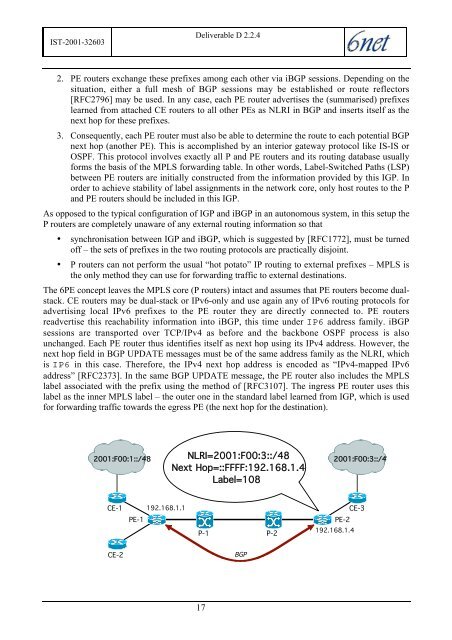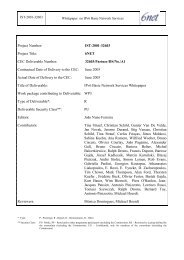D2.2.4: Final IPv4 to IPv6 Transition Cookbook for ... - 6NET
D2.2.4: Final IPv4 to IPv6 Transition Cookbook for ... - 6NET
D2.2.4: Final IPv4 to IPv6 Transition Cookbook for ... - 6NET
You also want an ePaper? Increase the reach of your titles
YUMPU automatically turns print PDFs into web optimized ePapers that Google loves.
IST-2001-32603Deliverable D 2.2.42. PE routers exchange these prefixes among each other via iBGP sessions. Depending on thesituation, either a full mesh of BGP sessions may be established or route reflec<strong>to</strong>rs[RFC2796] may be used. In any case, each PE router advertises the (summarised) prefixeslearned from attached CE routers <strong>to</strong> all other PEs as NLRI in BGP and inserts itself as thenext hop <strong>for</strong> these prefixes.3. Consequently, each PE router must also be able <strong>to</strong> determine the route <strong>to</strong> each potential BGPnext hop (another PE). This is accomplished by an interior gateway pro<strong>to</strong>col like IS-IS orOSPF. This pro<strong>to</strong>col involves exactly all P and PE routers and its routing database usually<strong>for</strong>ms the basis of the MPLS <strong>for</strong>warding table. In other words, Label-Switched Paths (LSP)between PE routers are initially constructed from the in<strong>for</strong>mation provided by this IGP. Inorder <strong>to</strong> achieve stability of label assignments in the network core, only host routes <strong>to</strong> the Pand PE routers should be included in this IGP.As opposed <strong>to</strong> the typical configuration of IGP and iBGP in an au<strong>to</strong>nomous system, in this setup theP routers are completely unaware of any external routing in<strong>for</strong>mation so that• synchronisation between IGP and iBGP, which is suggested by [RFC1772], must be turnedoff – the sets of prefixes in the two routing pro<strong>to</strong>cols are practically disjoint.• P routers can not per<strong>for</strong>m the usual “hot pota<strong>to</strong>” IP routing <strong>to</strong> external prefixes – MPLS isthe only method they can use <strong>for</strong> <strong>for</strong>warding traffic <strong>to</strong> external destinations.The 6PE concept leaves the MPLS core (P routers) intact and assumes that PE routers become dualstack.CE routers may be dual-stack or <strong>IPv6</strong>-only and use again any of <strong>IPv6</strong> routing pro<strong>to</strong>cols <strong>for</strong>advertising local <strong>IPv6</strong> prefixes <strong>to</strong> the PE router they are directly connected <strong>to</strong>. PE routersreadvertise this reachability in<strong>for</strong>mation in<strong>to</strong> iBGP, this time under IP6 address family. iBGPsessions are transported over TCP/<strong>IPv4</strong> as be<strong>for</strong>e and the backbone OSPF process is alsounchanged. Each PE router thus identifies itself as next hop using its <strong>IPv4</strong> address. However, thenext hop field in BGP UPDATE messages must be of the same address family as the NLRI, whichis IP6 in this case. There<strong>for</strong>e, the <strong>IPv4</strong> next hop address is encoded as “<strong>IPv4</strong>-mapped <strong>IPv6</strong>address” [RFC2373]. In the same BGP UPDATE message, the PE router also includes the MPLSlabel associated with the prefix using the method of [RFC3107]. The ingress PE router uses thislabel as the inner MPLS label – the outer one in the standard label learned from IGP, which is used<strong>for</strong> <strong>for</strong>warding traffic <strong>to</strong>wards the egress PE (the next hop <strong>for</strong> the destination).2001:F00:1::/48NLRI=2001:F00:3::/48Next Hop=::FFFF:192.168.1.4Label=1082001:F00:3::/48CE-1PE-1192.168.1.1P-1 P-2CE-3PE-2192.168.1.4CE-2BGP17






